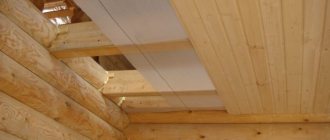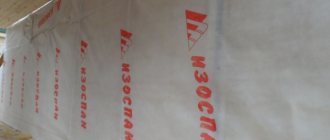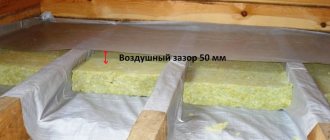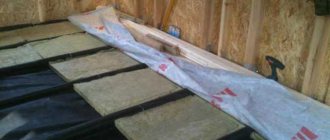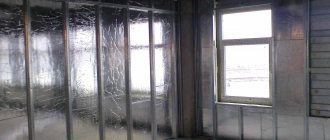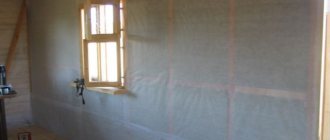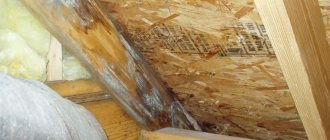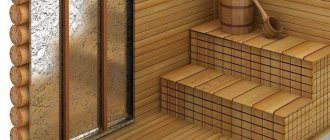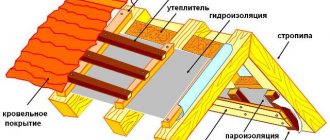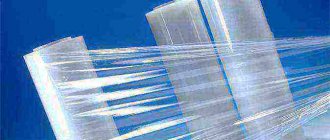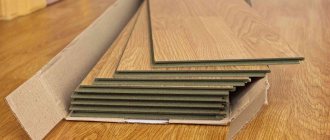Why is vapor barrier necessary?
The weather in the off-season is changeable. The air temperature can fall and rise. Insulation with special means will protect against condensation formed during the appearance of steam. Gradually the walls, floor and ceiling of the balcony will become damp.
This can lead to the appearance of fungus, which will be difficult to get rid of.
Many people believe that if the conditions on the street are always normal (for example, in the southern part), then such a process can be dispensed with. This is not true; vapor barrier is necessary for all closed loggias, without exception.
Main characteristics of vapor barrier materials
Vapor barrier layer:
- reliably waterproofs the room, thereby eliminating the appearance of condensation;
- retains the qualities of a sound-absorbing and heat-insulating layer;
- serves as a barrier against moisture.
Based on all of the above, it is clear that it is impossible to do without a vapor barrier when finishing a balcony.
When buying waterproofing with such properties in a store, keep in mind that the reliability of the waterproofing depends on the strength index. The larger this parameter, the more reliable it is. The most convenient are insulating products that do not need to be secured in complex ways. It will also be important what water pressure such a waterproofing material can withstand. This characteristic will guarantee that moisture will not penetrate into the room.
Types of vapor barrier
Vapor barriers have different purposes. Vapor-permeable membranes and films are most often used for finishing balconies. In the first case, steam cannot pass through the product. Insulating films prevent moisture from entering from the street. They protect against heat loss and even the strongest winds.
The vapor barrier layer should be under the insulation (for example, under mineral wool). Mineral wool has very poor protection against condensation penetration, so covering with a waterproofing layer will not be superfluous. You can use aluminum foil film or polyethylene with a reinforced coating for this purpose. If such a waterproofing agent is used, good ventilation in the loggia is necessary.
Moisture does not accumulate on some types of vapor barrier. Their anti-condensation properties are due to the existing fabric layer on the reverse side. The liquid accumulates on this coating and does not escape into the room. The film is laid so that the fabric side is on the bottom. The size between it and the insulation should be about 5-7 cm.
Vapor-permeable membranes are suitable for thermal insulation of the outer side of the walls of a balcony or its roof. In the latter case, such an insulator is applied to the top layer. Thanks to this, moisture accumulates only on the insulation and does not enter the loggia.
Laying features: which side?
Most vapor barrier materials are double-sided. In this case, one of the first questions that interests those who are planning to carry out insulation on their own, but do not have such experience, is the following: which side should the vapor barrier be laid to the insulation and is there any difference at all?
Of course there is a difference. An incorrectly installed vapor barrier on a balcony will be either less effective or not effective at all. Vapor barrier material can be laid both outside and inside. Its location depends on this:
- for external insulation of facades, the vapor barrier is placed on the outside of the insulation;
- when insulating walls internally, a vapor barrier is laid as an inner layer on top of mineral wool or polystyrene foam;
- when insulating the ceiling, the vapor barrier is also laid after the heat insulator.
But we are more interested in another question - which side to put the vapor barrier on, right? Everything is simple when it comes to a budget film option. This is a material that can be attached in any way you like. But if it has a fabric side (special anti-condensation films), then it should be laid with this side out.
When using a foil covering for internal insulation of a room, the foil should face the inside of the balcony or loggia.
Diffusion films are more difficult to install, which is why they often come with manufacturer's instructions. They can be one-sided or two-sided, and the installation principle depends on this. Typically, double-sided membranes differ in the color intensity of the sides and are laid with the dark side facing out, but there may be differences depending on the model and manufacturer.
Membrane types
Membranes with vapor barrier characteristics are divided into several types:
- Pseudo-diffusion (perforated). Essentially these are reinforced films or combined fabrics with small holes across the entire surface. Their vapor permeability coefficient is approximately 300 g/m². These membranes are used for waterproofing under roofs. Among the disadvantages, they note the possible entry of dust into the perforations or blockage of the holes with frost during the cold season.
- Diffusion (porous). Their structure is similar to fiber. The pores of these membranes become clogged differently than those of perforated membranes. Therefore, they are the preferred means of creating an air layer over the insulation. Its vapor permeability coefficient is at the level of 1000 g/m².
- Superdiffusion (multilayer). These membranes are assembled in several layers. They do not clog because they are not perforated. This vapor barrier element is suitable for arranging balconies in areas with high dust levels. Pollution and moisture will not penetrate into the room through it. The condensate permeability coefficient ranges from 900 to 2500 g/m².
Membranes made from three layers are considered the highest quality and most expensive.
The most commonly used is their two-layer variety.
How to properly make a vapor barrier for a balcony with your own hands. Step by step
The installation of most types of vapor barriers begins before installing the insulation on the balcony. Therefore, before starting work, you need to clear the area of foreign objects and remove dirt and dust. It is also recommended to dismantle the door frame threshold.
If cracks are found on the balcony slab or walls, they must be filled with foam to prevent moisture penetration. Large chips and cracks are repaired with cement-sand mortar.
After the preparatory work, they begin to prepare the insulating material. For high-quality installation of vapor barrier, you need to correctly position the material in relation to the insulation. When using double-sided films, use the following installation scheme:
- when protecting external walls, the insulation is mounted outside the insulation layer;
- when processing internal surfaces, the material is laid on top of the laid insulation;
- when working with the ceiling, the vapor barrier is also attached after installing the insulation;
- if the membrane material consists of a porous fabric and a foil layer, the fabric is placed outside, and the reflective surface is laid facing the inside of the room.
The installation of a vapor barrier is carried out on a wooden sheathing, which serves as the basis for internal or external cladding. The film can be secured with double-sided tape or by nailing it with metal staples using a furniture stapler.
Step-by-step algorithm:
- Double-sided tape is glued around the perimeter of the sheathing. If the vapor barrier extends onto the adjacent wall, a strip is also glued onto it at a height of 200-250 mm.
- A measured piece of insulation is glued along the length of the upper part of the surface to be treated.
- Gradually, the material is straightened over the entire surface, while simultaneously removing the protective film from the lower elements of the sheathing and pressing the fabric against the tape.
- When all the sheets are installed, begin gluing the joints of the individual sheets with tape.
- Installation using a furniture gun also begins from the top of the surface, gradually moving down.
Finishing the loggia with a vapor barrier: the best materials
Manufacturers offer a large number of layers for vapor insulation:
- Tyvek from DuPont . It has increased elasticity and strength. This membrane from the Luxembourg brand can be used in any climate. Thanks to special layers, the balcony will not be stuffy.
- Yutafol . The Czech development does not allow moisture to pass through, and condensation evaporates from the surface of the walls and floor without obstacles. Most often used on sloping roofs.
- Penoizol . A popular layer for vapor barrier on loggias. Thanks to its special composition, the substance can retain moisture and evaporate it over time.
- Delta. Such materials from the German brand are characterized by high strength and long service life.
- Megaisol . Has excellent insulating properties. Can be pasted on the ceiling, walls and floor. It must be laid on top of the insulating fiber. The metallized coating reliably protects against moisture penetration, and the inner layer traps fumes inside and prevents them from lingering on the loggia.
- Izospan . It simultaneously serves as insulation and isolates steam on the balcony. Provides excellent insulation and does a good job of removing moisture from any internal structure.
- Penofol . It has good thermal conductivity, flexibility and water resistance. The membrane is very thin, but at the same time it protects well from frost getting inside.
In addition to all of the above, liquid rubber is popular in waterproofing balconies. This material serves as good protection for reinforced concrete joints and connections.
Balcony vapor barrier materials
Not every material is suitable for installing a vapor barrier on the inner surface of balcony insulation. To do this, at a minimum, the outer layer must have complete waterproofing, and the inner layer must have one-way conductivity. It is best not to experiment, but to use a ready-made solution for vapor barrier of warm rooms.
Tyvek Yutafol or the cheaper Yutafol Delta have excellent vapor barrier properties. From domestic materials, Delta Izospan is used, but subject to the provision of a ventilation duct between the insulation and the laid thermal insulation. Any of the vapor barriers cannot be laid directly on the insulation; there should be a small space left on the inside of the balcony room for air circulation.
Preparatory work
Many home craftsmen are interested in how to make a vapor barrier under insulation on a loggia and is it difficult? Protection against condensation must be carried out before insulation. To make it, you need to remove the debris, remove the balcony threshold and door frame. If there are gaps or cracks, they should be sealed with foam installation foam.
After it dries, it is necessary to eliminate the irregularities by cutting them off with a construction knife. The vapor barrier layer can be installed when the wall surface is completely ready.
Laying the material will vary depending on its type:
- when insulating the ceiling, the steam film is attached to the insulation;
- for internal cladding with foam plastic or mineral wool, insulation is laid between the layers;
- installation on the outside of insulating materials is carried out if the facade is insulated from the outside.
Some anti-moisture products have a fabric side. When installing it, this surface is positioned so that it “looks” outward. If internal insulation is carried out with a foil membrane, it is placed on the inside of the walls.
Preparing the balcony for insulation
The crumbled filling of the seams is cleaned, and holes, cracks and crevices are filled with foam. Moreover, it is recommended to fill seams more than 6 cm wide gradually - in several stages.
Irregularities are eliminated on the surfaces of walls and ceilings. Removes dust and significant dirt
The floor is thoroughly swept (it is better to vacuum). If there is electrical wiring on the balcony, it is important to ensure its integrity.
To insulate a balcony with penofol, you will need the following construction tools and materials: drill, knife, self-tapping screws, stapler, disc dowels, polyurethane foam, wooden blocks and slats, polystyrene foam, foil tape, penoplex and others.
Vapor barrier of the floor on the balcony
To insulate this area of the loggia from steam, a slatted sheathing is installed. After it, a vapor barrier strip is placed. Boards or plywood will serve as the floor surface. Linoleum or laminate should be laid on top of them. In the latter case, an additional thin polyurethane backing is needed.
Be sure to place vents in the space under the floor. They need to be connected to ventilation ducts. Then the vapor barrier of the balcony will function normally.
To create insulation from steam and at the same time insulate the floor, you can use Izospan. This material is cut into small rectangular pieces and overlapped. Its size should be about 8-10 cm. To prevent the edges of the vapor barrier gasket from coming apart, they are glued with construction tape.
Balcony vapor barrier during insulation
Anti-condensation devices are installed in different ways. Which one is preferred will depend on the purpose of the material. For example, a vapor barrier film can be used to insulate the walls inside a balcony. In this case, it is glued from the side of the room on top of the insulation.
Anti-condensation membranes are installed on the side facing the street. Using these means, moisture is removed from the thermal insulation. The vapor barrier of the loggia is carried out in different ways, depending on the material that was used.
For example, if there is a foil or anti-condensation (fabric) layer on the film, it must be located indoors. With two identical sides, it can be laid in any way you like. Diffusion materials to prevent steam penetration into the loggia have different surface colors. Which side should be used to lay such a moisture-retaining product is written in the instructions from the manufacturer.
Types of vapor barrier
Before you figure out how to properly install a vapor barrier, you need to understand what types of vapor barrier materials there are and what their features are. Three main groups can be distinguished:
- Film is a material that does not allow moisture to pass through at all. Its advantages also include being budget-friendly - it is the most affordable type of vapor barrier . There is also a two-layer film on sale - one layer is smooth, the second is embossed (this film is laid with the embossed layer outward, so that drops of moisture do not flow down the film, but remain at a certain level until they evaporate).
- The membrane is a porous material, but with limited vapor permeability. Thanks to these properties, moisture is not retained in the insulation (that is, the insulation does not get wet, which can significantly affect its effectiveness), but is removed. There are membranes of pseudo-diffusion type (vapor permeability - up to 300 g per 1 sq. m. per day), diffusion (vapor permeability - 300-1000 g per 1 sq. m. per day), superdiffusion (vapor permeability - more than 1000 g per 1 sq. m. per day). . per day). There are also volumetric membranes - in them the ventilated layer is located inside. All of them are mainly used in outdoor work.
- Foil vapor barrier - a material that has not only vapor barrier properties, but also thermal insulation. It is offered by different manufacturers. Depending on the composition of the material, the properties of the insulator vary somewhat.
- Izospan is made from polypropylene fabric with a metallized layer.
- Penofol is a thin material made of polyethylene foam and coated with aluminum foil, which prevents heat loss at all three stages: convection, thermal conductivity, radiation.
- Megaizol - this manufacturer’s line of films also includes models with a metallized coating.
If you can’t decide what material you need, contact your sales consultant for help. Having studied the features of the room and found out the estimated budget for the vapor barrier layer, he will help you choose the best option.
You can learn more about the characteristics of foil penofol and its properties from our separate article.
Pay attention to our step-by-step instructions for insulating balconies with your own hands. It discusses the use of the most popular materials.
After vapor barrier of the loggia, you can proceed to finishing. You can read about cladding using lining here.
Is a vapor barrier necessary when insulating a balcony with polystyrene foam?
Many home craftsmen are confident that when using such insulation there is no need for anti-condensation agents. They are partly right, and the use of waterproofing will depend on the technology and method of laying penoplex (extruded polystyrene foam).
Sheets of this insulation are laid with an overlap or lock of 2 or 3 cm thanks to a special groove along the edge. It is made in the shape of the letter G. Expanded polystyrene is attached to the surface of the walls using waterproof glue. In this case, moisture and water vapor do not enter the balcony from the street. The disadvantage of this method is that it will become stuffy inside the room.
Vapor barrier with expanded polystyrene
To avoid this, it is recommended to use forced ventilation in the upper part of the loggia under the roof. A loggia insulated with polystyrene foam will still transmit heat, so it requires mandatory insulation from frost.
If there are even small gaps in the tightness and the joints are broken, steam from the cold street can enter the loggia and freeze under the insulating lining.
And under the weight of snow and ice in winter, polystyrene foam can break.
How to lay a vapor barrier on a balcony
When joining the film, the layers must be laid on top of each other, this ensures that there is no empty space. Along the edges, the vapor barrier material has a special mesh that will help you navigate when creating overlaps. Metallized tape should be used for gluing joints.
Ceiling vapor barrier on the balcony
The very first surface on the balcony that must undergo vapor barrier is the ceiling. The gaseous mass first tends upward, which means that it will be the central place for the accumulation of mold. In this case, penoplex vapor barrier will not help to insulate the loggia, as small cracks will remain.
Don't leave empty space in the ceiling
First, you need to lay a vapor barrier layer of film, and then install a sealing element. Next, install polystyrene foam boards, and then lay down a waterproofing coating.
Attention! The voids between the vapor barrier and the top layer of the ceiling will always collect large amounts of vapor.
Vapor barrier of the floor on the balcony
Installing a vapor barrier on the loggia floor during insulation is the most difficult, since in this case the environmental conditions play an important role. The only advantage is that there is no need to install floor coverings on the floor side. First of all, you will need to lay polystyrene foam on the floor. It must be installed tightly to the end surfaces, and then insulated. Next, lay the screed with a waterproofing layer, as liquid retention will be required. Typically, little steam will accumulate on the floor, so there will be cold air present in this environment.
One material can be used to vapor barrier walls and floors
Vapor barrier of walls on the balcony
The vapor barrier of a balcony along the walls when insulated from the inside is calculated based on the material with which the surfaces are equipped. In any case, it is necessary to use penoplex as insulation, however, not every material can act as a vapor barrier layer. If the walls are made of brick or concrete, then you can use double film with a foil surface. According to the rules, the reverse side should be located in the interior of the finish. When the wall is wooden, then such a film is absolutely not needed, since penoplex is enough for vapor barrier.
You can strengthen the vapor barrier layer using glazing beads or metal profiles
When the vapor barrier of a balcony is carried out from the outside, in most cases it is necessary to use penoplex. The main advantage is that liquid or steam cannot form on the outside, and if moisture does appear, it will not be able to seep into the wall.
Recommended ventilation gap size
In order for ventilation to be effective, you need to know how to use anti-condensation film. It is best to make a gap in the range from 4 to 7 cm. If diffusion-type membranes are used, you can not leave it, but lay them directly on the thermal insulation materials.
Protective membranes have different characteristics. In order to make it clear exactly how to lay such a moisture barrier element, manufacturers mark the material with markings. If they are not there, then an anti-condensation membrane must be applied with a gap of 8-15 cm.
How to seal joints?
Some craftsmen incorrectly glue films and membranes for vapor barriers from the inside and outside. So they start to move away. To prevent this from happening, single-sided or double-sided self-adhesive tape is best. It is made from butyl rubber, propylene, butylene and foam or regular polyethylene.
Typically, manufacturers indicate in the instructions for such vapor barrier products which tape is suitable. You should not use office tape for this purpose. It has a short service life and does not provide 100% tightness when sealing joints.
Methods of securing material
To securely fasten anti-condensation agents, nails with a large head are used. They will help to fix the film well on the surface of the insulation. A construction stapler will also securely fasten the film or membrane. Experts recommend fixing the vapor barrier with counter-straps. This option will firmly hold the anti-condensation layer on the surface.
Many home craftsmen who have never encountered the installation of vapor barrier materials think that the tension of such products must be very strong. They believe that this will reduce material consumption and ensure its evenness. Experts say you shouldn't do this. Even with the slightest temperature changes, waterproofing films and membranes begin to shrink.
The material used to protect against moisture penetration onto the balcony may tear or crack. This will happen if you do not leave the necessary reserves. To ensure that the condition of the waterproofing remains normal, make sure that it sags at a level of 2 cm.
Installation nuances
During the process of installing a vapor barrier (and sometimes even earlier), a number of questions may arise, the answers to which will determine the correct vapor barrier for a balcony with your own hands. Of course, it is better to get a preliminary consultation with a specialist. But when you don't know what you're dealing with, it's hard to imagine what problems might arise. And yet, we will consider the main issues.
Overlap or butt?
If you need to lay two strips of vapor barrier material side by side, what is the best way to do it - overlapping to avoid unfilled space, or end-to-end so as not to layer one vapor barrier layer on top of another?
The film must be overlapped. If you pick up a roll of vapor barrier film, you can see that there are markings along its edges (usually the distance from the edge to the marking line does not exceed 10-20 cm) - this will be a guideline for the overlap. A diffusion-type membrane can also be installed with an overlap. And if it is used to insulate the roof, then the side parts of the insulation are also covered with vapor barrier material.
Thicker material based on polyethylene foam, such as Penofol, is recommended to be laid end-to-end.
What to glue with?
Elements of the membrane and film at the junction of the panels, at window and door openings must be glued to ensure tightness. For this purpose, single-sided or double-sided self-adhesive tapes are used. It is also possible to use metallized tape.
Using self-adhesive tape, you can also repair a vapor barrier if you need to replace part of it or eliminate a gap or hole.
The membrane film can also be attached not to tapes, but to a construction stapler, nails and counter-battens.
How to tension?
The first thought is to stretch the canvas as much as possible to reduce material consumption and ensure an even layer of coverage. But in fact, this solution is not entirely correct, since when the temperature changes, the vapor barrier film can shrink, and if a small reserve is not provided, it will crack and then tear. It is better to lay the vapor barrier with a slight sag of 1-2 cm where possible.
Since the membrane is a priori an impermeable or low-permeability layer, it is also important to properly organize the ventilation gap between the vapor barrier layer and the finishing material, which serves to remove condensate.
Installing a vapor barrier layer, provided you know which side to attach the vapor barrier to, will create a more comfortable microclimate on the balcony or loggia. Proper insulation lasts for decades and does not require repair. And besides, this is also a significant saving on heating, because even in the coldest months the heat will remain indoors and not go outside.
Installation stages
Reminder for those who do vapor barrier
Waterproofing should be laid according to the following scheme:
- The film or membrane for insulation from moisture must be overlapped. Its approximate size is about 15 cm.
- The clamping strip is screwed at the joint to the frame, or the overlapping seam is sealed with vapor barrier tape. These actions are necessary to ensure air permeability of the joints.
- Lathing or slats guarantee the stability of the vapor barrier film. You can cover the places where the staples are attached with adhesive tape. This material should not be allowed to hang freely.
- Clearance for movement is required. It should be located at the joints between structures.
If even small holes or gaps remain, they must be sealed with waterproofing tape. When using foamed polyethylene, it is laid end-to-end. Gluing them will help ensure tightness around window sills, window frames and door jambs. Metallized or self-adhesive tape is suitable for this purpose. It is not recommended to use regular office tape. It has a short service life and will come off the walls over time.
How to lay the material correctly
All vapor barrier materials are produced double-sided. They are installed both externally to insulate facades and internally to insulate walls and ceilings. If you use cheap film material, then it does not matter which side you attach it to. Laying with the outer side is carried out if one side has a fabric base.
Many people use diffusion films. Their fastening is quite complicated, so before starting this process you should read the instructions. They are one-sided and two-sided, with one side painted. It is this side that installation is carried out.
Questions during the installation process
When attaching a vapor barrier material with your own hands, many questions arise. Some of them:
- How are the sheets attached to each other? Two sheets of vapor barrier material can be overlapped or butt-jointed. The first method is used for film. It is sold in rolls. At the ends, the distance at which the next roll should lie when overlapped is indicated. Thus, the film reliably covers the thermal insulation from moisture penetration.
- How to attach vapor barrier material? Small elements near window and door openings are sealed with special tape. It can be fastened using a construction stapler. In some cases, metallized tape is used. Using these materials, you can repair the vapor barrier: seal the hole or replace a broken element.
Self-adhesive construction tape used for vapor barrier
- How to stretch sheets? The material is stretched tightly to reduce vapor barrier costs and also provide a smooth surface. However, when the temperature changes, the film shrinks, so there is no need to stretch it too much; it is better to leave a small margin (1-2 cm). There must be a gap between the thermal insulation and the vapor barrier, which serves as ventilation and condensate removal.
Protection of the facade from moisture penetration
Expanded polystyrene can absorb a small amount of moisture. Water from the street can penetrate into it to a depth of 5 mm. Over time, this insulation will begin to chip and peel off after freezing. This situation can happen even if the walls have metal, plastic or plywood cladding.
To prevent evaporation from penetrating deep into the foam, the outer surface must be covered with film. If the walls of the loggia facing the street are lined with corrugated sheets or metal, then you cannot do without waterproofing.
